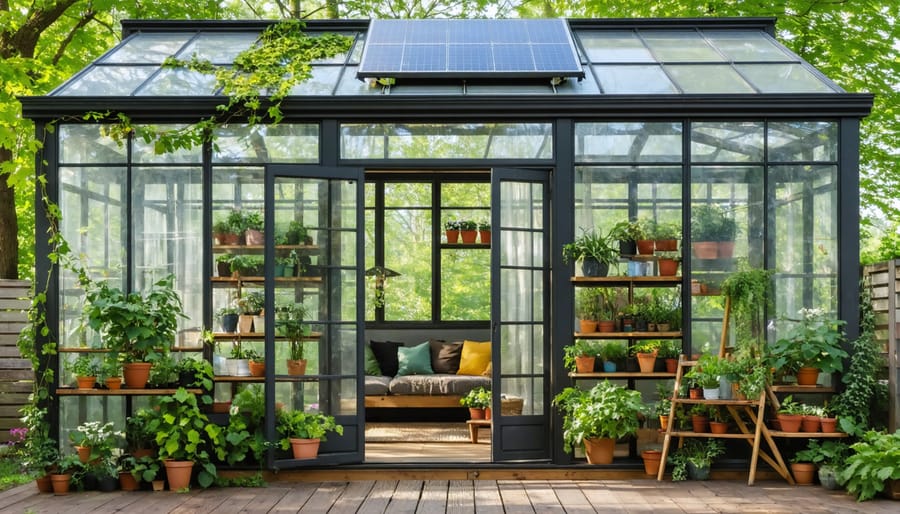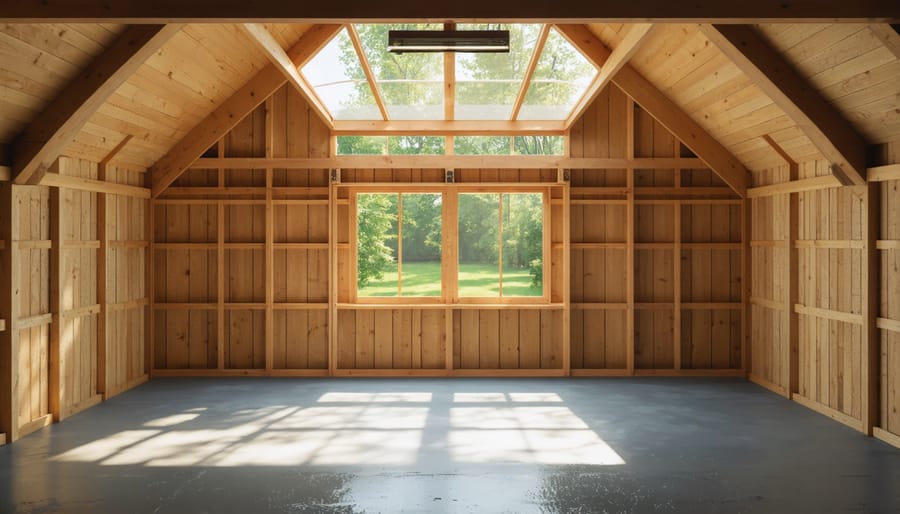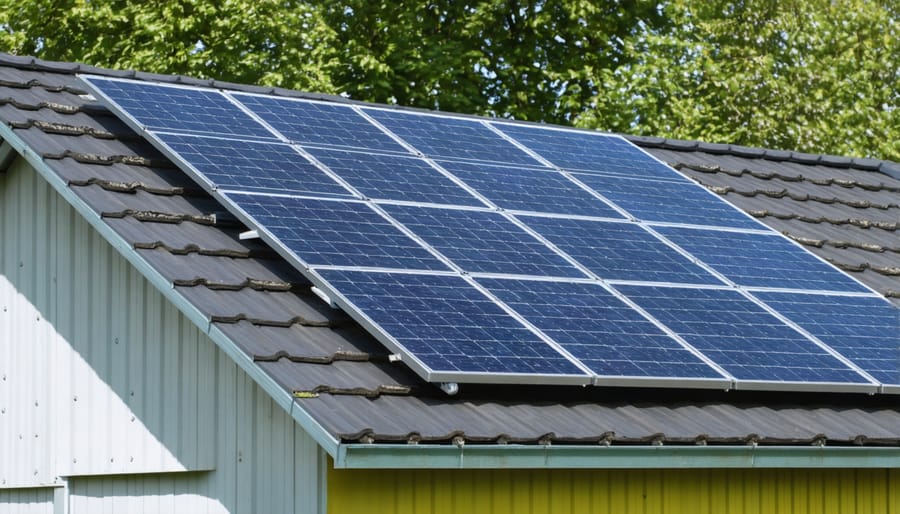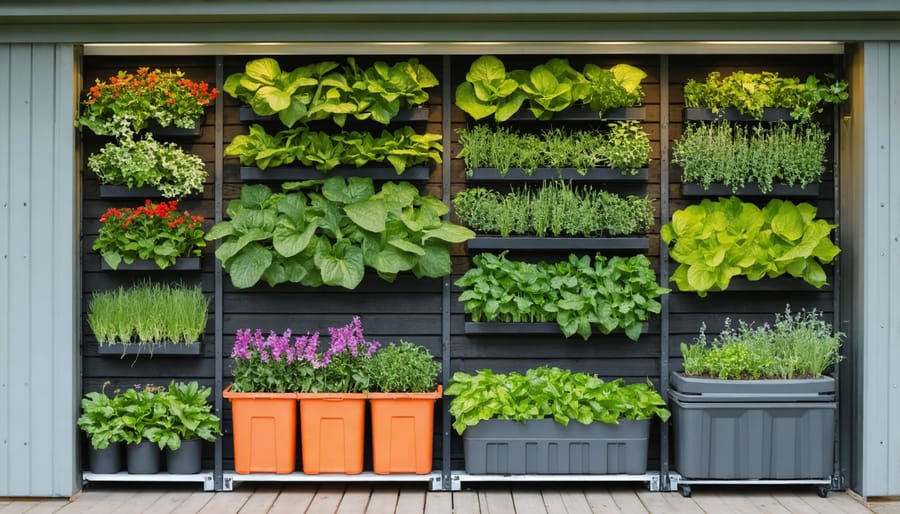Transform Your Old Shed into an Eco-Friendly Garden Sanctuary

Transform your backyard retreat into a stunning greenhouse-she shed hybrid that serves both as a thriving plant sanctuary and a personal oasis. This versatile space combines the practical aspects of a traditional greenhouse with the cozy comfort of a she shed, creating the perfect balance between functionality and relaxation. Whether you’re nurturing delicate seedlings or seeking a peaceful escape, a greenhouse-she shed offers year-round possibilities for both gardening enthusiasts and those craving a private retreat.
Picture windows flooding the space with natural light, rustic wooden shelves adorned with flourishing plants, and a comfortable reading nook nestled among trailing vines – this is more than just a storage solution or growing space. It’s a personalized haven where you can pursue your passion for gardening while enjoying a dedicated space for creativity, relaxation, or hobby work.
From salvaged French doors to repurposed materials, your greenhouse-she shed can reflect your unique style while maintaining ecological consciousness. Modern designs incorporate sustainable features like rainwater collection systems, solar-powered ventilation, and energy-efficient insulation, making it an environmentally friendly addition to your property that serves multiple purposes throughout the changing seasons.
Sustainable Design Principles
Natural Lighting Solutions
Natural lighting is a game-changer for greenhouse and she shed spaces, creating an inviting atmosphere while reducing energy costs. Strategically placed windows on multiple walls allow sunlight to flood your space throughout the day, creating optimal conditions for plants and providing plenty of natural light for crafting or reading.
Skylights are particularly effective, offering up to 30% more natural light than vertical windows. Consider installing fixed skylights for consistent overhead lighting or ventilated options that can open to release excess heat during summer months. For spaces where traditional skylights aren’t feasible, solar tubes provide an excellent alternative. These innovative devices capture sunlight through a dome on the roof and channel it down through a reflective tube, brightening even the darkest corners of your structure.
For maximum energy efficiency, opt for double-paned windows with low-E coating, which help maintain comfortable temperatures year-round. Position larger windows on the south-facing wall to capitalize on natural warmth during winter months, while smaller windows on the north side can provide gentle, indirect light perfect for delicate plants or detailed work.

Sustainable Materials
When building your greenhouse or she shed, choosing eco-friendly construction materials not only benefits the environment but also creates a healthier space for you to enjoy. Consider reclaimed wood from local sources for the frame and walls – it adds character while reducing waste. Recycled glass windows are perfect for greenhouses, offering both functionality and sustainable charm. For roofing, look into recycled metal sheets or sustainable rubber tiles made from repurposed materials.
Bamboo is an excellent renewable resource that works well for interior finishing and decorative elements. For insulation, opt for natural materials like sheep’s wool or recycled denim, which provide excellent temperature control without harmful chemicals. Salvaged doors and hardware can add unique personality while keeping materials out of landfills.
Many local salvage yards and architectural recycling centers offer high-quality used materials at fraction of the cost of new ones. Remember to check for weather resistance and proper treatment when selecting recycled materials to ensure your structure remains durable and beautiful for years to come.
Green Energy Integration
Solar Panel Installation
Adding solar power to your greenhouse or she shed can transform it into a self-sufficient haven while reducing your environmental impact. Installing solar power systems doesn’t have to be overwhelming – start by assessing your energy needs and available roof space. A basic setup typically includes solar panels, a charge controller, batteries for storage, and an inverter.
For most greenhouse or she shed applications, a 500-1000 watt system should suffice, powering essentials like lighting, small appliances, and ventilation fans. South-facing roof sections are ideal for panel placement, but east or west-facing installations can also work effectively. Consider using flexible or thin-film panels if your structure has weight limitations.
Before installation, ensure your roof can support the additional weight and check local building codes and permit requirements. Many homeowners start with a small system and expand as needed. Mount your panels at a 30-45 degree angle for optimal sun exposure, and keep them clean from debris and dust for maximum efficiency.
Remember to include a backup power solution for cloudy days, and install surge protection to safeguard your equipment. Many DIY enthusiasts successfully complete their own installations, but don’t hesitate to consult professionals for complex setups or electrical connections.

Energy-Efficient Climate Control
Creating a comfortable environment in your greenhouse or she shed doesn’t have to strain your energy bills or the environment. Start with strategic window placement to maximize natural airflow. Installing windows on opposite walls encourages cross-ventilation, while roof vents help release hot air that naturally rises. Adding adjustable window screens lets you control airflow while keeping insects out.
For sustainable cooling, consider installing solar-powered exhaust fans or traditional whirlybird roof ventilators. These work wonders on hot days without using electricity. Retractable shade cloths or natural vine coverage can provide additional cooling by blocking intense sunlight during peak hours.
In colder months, passive solar heating can maintain comfortable temperatures. Position large windows to face south (in the Northern Hemisphere) to capture maximum sunlight. Installing thermal mass materials like concrete floors or water barrels helps store heat during the day and release it at night. For supplemental heating, consider energy-efficient options like small electric infrared heaters or solar air heaters.
Smart insulation plays a crucial role year-round. Use weather stripping around doors and windows, and consider installing double-pane glass or polycarbonate panels. Adding insulation to walls and ceilings dramatically reduces temperature fluctuations while keeping your energy costs low.
For precise climate control, install a programmable thermostat connected to your ventilation system. This ensures optimal conditions while minimizing energy usage, making your greenhouse or she shed comfortable and efficient throughout the year.
Water Conservation Features
Rainwater Harvesting
Transform your greenhouse or she shed into an eco-friendly oasis by incorporating a smart rainwater harvesting system. For detailed instructions, check out our comprehensive rainwater harvesting guide. Start by installing gutters along your structure’s roofline, ensuring they slope gently toward your collection points. Position rain barrels or larger storage tanks at downspout locations, making sure they rest on level, stable surfaces.
Consider installing a first-flush diverter to prevent debris from entering your storage system, and add mesh screens over collection points to keep out leaves and insects. For aesthetic appeal, paint or decorate your storage containers to match your shed’s design, or conceal them with climbing plants or decorative screens.
Connect your storage system to a drip irrigation setup for your greenhouse plants, or use the collected water for container gardens and outdoor cleaning tasks. During dry spells, you’ll appreciate having this sustainable water source readily available, potentially reducing your water bills while supporting your garden’s needs.
Greywater Systems
A greywater system can transform your greenhouse or she shed into an eco-friendly oasis while reducing water waste. By collecting and reusing water from sinks, showers, or washing machines, you can create a sustainable irrigation system for your plants. Install a simple collection tank beneath your sink or connect existing drainage pipes to direct greywater to your greenhouse beds.
Remember to use plant-friendly soaps and cleaners since this water will nourish your garden. A basic filtering system using gravel and sand can help remove debris before the water reaches your plants. For smaller spaces, consider a portable greywater collection system that can be easily moved as needed.
Strategic placement of plants can maximize your greywater system’s efficiency. Position water-loving plants closer to water sources, and use gravity to your advantage by creating gentle slopes in your irrigation channels. Install a monitoring system to track water usage and adjust flow rates according to your plants’ needs.
For best results, combine your greywater system with rainwater harvesting to ensure a consistent water supply throughout the year.
Interior Design and Organization
Sustainable Furnishing
When furnishing your greenhouse or she shed, choosing sustainable materials not only benefits the environment but also creates a more harmonious space. Consider reclaimed wood furniture, which adds character while reducing environmental impact. Local thrift stores and antique shops often offer unique pieces that can be upcycled with eco-friendly paint or natural finishes.
For seating, look for pieces made from recycled materials or sustainable bamboo. Weather-resistant cushions filled with organic cotton or recycled polyester provide comfort while maintaining eco-consciousness. Vintage metal garden furniture can be restored with non-toxic rust treatments and paint, giving new life to classic pieces.
Storage solutions can include repurposed wooden crates, sustainable wicker baskets, or secondhand shelving units. Natural fiber rugs made from jute or sisal add warmth while being biodegradable. Consider installing cork flooring, which is both renewable and provides excellent insulation.
Decorative elements should reflect your sustainable approach. Hang macramé plant holders made from organic cotton, display air plants in recycled glass containers, and incorporate LED solar-powered lanterns for ambient lighting. Choose low-VOC paints and natural stains for any DIY projects.
Remember to source locally when possible, reducing transportation emissions and supporting your community’s artisans. Many craftspeople specialize in creating furniture from sustainable or reclaimed materials, offering unique pieces that tell a story while preserving our planet’s resources.
Vertical Growing Systems
Transform your greenhouse or she shed into a verdant paradise by maximizing vertical space with innovative growing systems. A well-designed vertical garden planning strategy can double or even triple your growing area while creating a stunning living wall effect.
Start with simple options like stackable planters and hanging baskets along your walls. These systems are perfect for growing herbs, strawberries, and trailing plants like ivy or petunias. For more advanced setups, consider installing modular wall panels with built-in irrigation systems, which can support everything from leafy greens to compact vegetables.
Utilize corner spaces with spiral plant stands or tiered shelving units that allow plants to cascade naturally. Pocket planters and fabric growing bags can be mounted directly onto walls, creating a lush tapestry of greenery while keeping floor space free for other activities.
Don’t forget to incorporate proper lighting at different heights to ensure all plants receive adequate illumination. LED grow lights can be strategically placed to supplement natural light, especially for lower-level plants that might be shadowed by those above.
Remember to choose plants that thrive in vertical conditions and match your space’s specific light and temperature patterns. Mix ornamental and edible varieties to create both beauty and functionality in your greenhouse or she shed sanctuary.

Maintenance and Longevity
Maintaining your greenhouse or she shed is crucial for ensuring its longevity and eco-friendly performance. Start by establishing a regular cleaning schedule – sweep floors, wipe down surfaces, and clean windows monthly to prevent dirt buildup and maximize natural light penetration. Check seals around windows and doors seasonally, replacing weatherstripping as needed to maintain energy efficiency.
For wooden structures, apply an eco-friendly sealant or preservative annually to protect against moisture and pest damage. If you’ve opted for sustainable materials like bamboo or reclaimed wood, inspect them twice yearly for signs of wear or water damage. Keep gutters and drainage systems clear of debris to prevent water accumulation around the foundation.
Monitor your ventilation system regularly, ensuring fans and vents operate smoothly. For greenhouse sections, clean plant debris promptly and maintain proper humidity levels to prevent mold growth. Consider installing a moisture meter to help track conditions inside your space.
Pay special attention to your green features – clean solar panels quarterly, check rain collection systems for leaks, and maintain any living walls or roof gardens according to their specific needs. Replace any LED bulbs that begin to dim and ensure your composting system, if present, remains well-balanced.
Address small repairs immediately to prevent larger issues from developing. Keep spare sustainable materials on hand for quick fixes, and maintain a detailed maintenance log to track the timing of regular upkeep tasks. With proper care, your eco-friendly shed can provide enjoyment and functionality for many years while maintaining its environmental benefits.
Transforming your garden shed into a greenhouse or she shed is more than just a home improvement project – it’s an investment in sustainability and personal wellbeing. By incorporating eco-friendly features like solar panels, rainwater collection systems, and recycled materials, you’re creating a space that’s both environmentally conscious and uniquely yours. These transformed spaces offer a perfect balance of functionality and tranquility, whether you’re nurturing plants year-round or seeking a peaceful retreat from daily stress.
The beauty of this project lies in its versatility and personal touch. Your greenhouse or she shed can evolve with your needs, serving as a gardening sanctuary, creative studio, or meditation space. The sustainable features not only reduce your environmental footprint but also lead to long-term cost savings through reduced energy and water consumption.
Ready to start your transformation journey? Remember that every small step counts – from installing your first recycled window to setting up your initial composting system. Your eco-friendly shed will soon become a testament to sustainable living and a source of inspiration for your community. Take that first step today and watch your vision bloom into reality.

